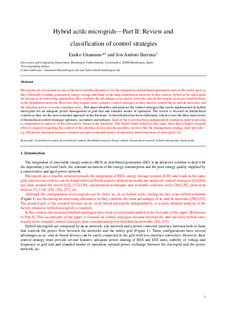Title
Hybrid ac/dc microgrids. Part II : Review and classification of control strategiesVersion
Postprint
Rights
© 2015 Elsevier LtdAccess
Open accessPublisher’s version
https://doi.org/10.1016/j.rser.2015.07.186Published at
Renewable and Sustainable Energy Reviews. Vol. 52. Pp. 1123-1134. December, 2015xmlui.dri2xhtml.METS-1.0.item-publicationfirstpage
1123xmlui.dri2xhtml.METS-1.0.item-publicationlastpage
1134Publisher
ElsevierKeywords
Centralized control
Decentralized control
Distributed control
Droop control ... [+]
Decentralized control
Distributed control
Droop control ... [+]
Centralized control
Decentralized control
Distributed control
Droop control
Hierarchical control
Hybrid
microgrids
Smart grids [-]
Decentralized control
Distributed control
Droop control
Hierarchical control
Hybrid
microgrids
Smart grids [-]
Abstract
Microgrids are envisioned as one of the most suitable alternatives for the integration of distributed generation units in the utility grid, as they efficiently combine generation, energy storage and l ... [+]
Microgrids are envisioned as one of the most suitable alternatives for the integration of distributed generation units in the utility grid, as they efficiently combine generation, energy storage and loads in the same distribution network. In this context, hybrid ac/dc microgrids are arising as an interesting approach as they combine the advantages of ac and dc networks and do not require excessive modifications in the distribution network. However, they require more complex control strategies as they need to control the ac and dc networks and the interface power converter simultaneously. This paper identifies and analyses the control strategies that can be implemented in hybrid microgrids for an adequate power management in grid-tied and islanded modes of operation. The review is focused on hierarchical controls as they are the most extended approach in the literature. A classification has been elaborated, which covers the three main levels of hierarchical control strategies (primary, secondary and tertiary). Each of the levels has been independently studied in order to provide a comprehensive analysis of the alternatives found in the literature. The future trends related to this topic show that a higher research effort is required regarding the control of the interface device and the ancillary services that the management strategy must provide—e.g. blackstart, transition between islanded and grid-connected modes of operation, interconnection of microgrids, etc. [-]
Collections
- Articles - Engineering [711]
Related items
Showing items related by title, author, creator and subject.
-
Development and validation of an automatic manufacturing process for fiberglass composites
Esnaola, Aritz (Dyna Publishing, 2023)Fiberglass reinforced polymeric composites are ideal for various applications due to their mechanical properties and lightweight. However, nowadays many fiberglass reinforced composite manufacturing processes are manual, ... -
On the Feasibility of Distinguishing Between Process Disturbances and Intrusions in Process Control Systems using Multivariate Statistical Process Control
Iturbe, Mikel; Garitano, Iñaki; Zurutuza, Urko; Uribeetxeberria, Roberto (IEEE, 2016)Process Control Systems (PCSs) are the operat-ing core of Critical Infrastructures (CIs). As such, anomalydetection has been an active research field to ensure CInormal operation. Previous ... -
Artificial Neural Network Based Reinforcement Learning for Wind Turbine Yaw Control
Lozano Silva, Javier (MDPI AG, 2019)This paper introduces a novel data driven yaw control algorithm synthesis method based on Reinforcement Learning (RL) for a variable pitch variable speed wind turbine. Yaw control has not been extendedly studied in the ...





















